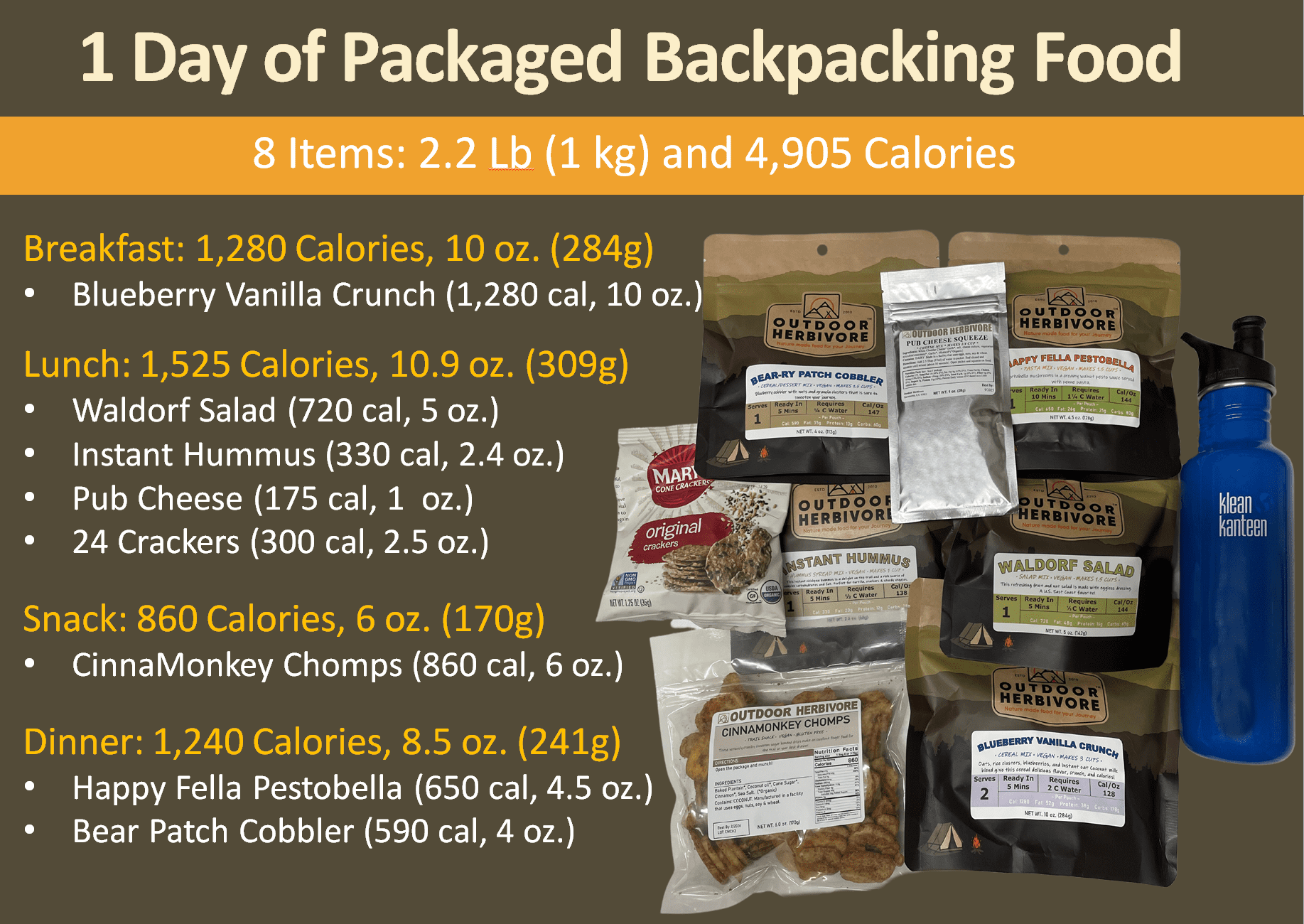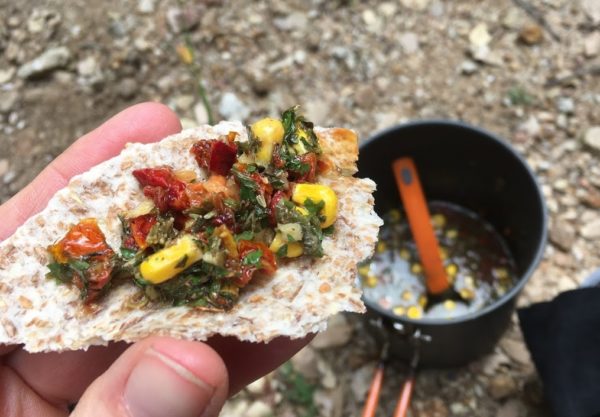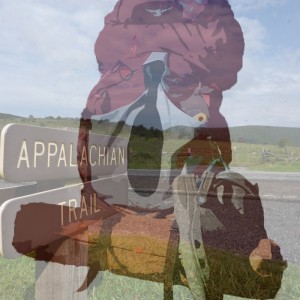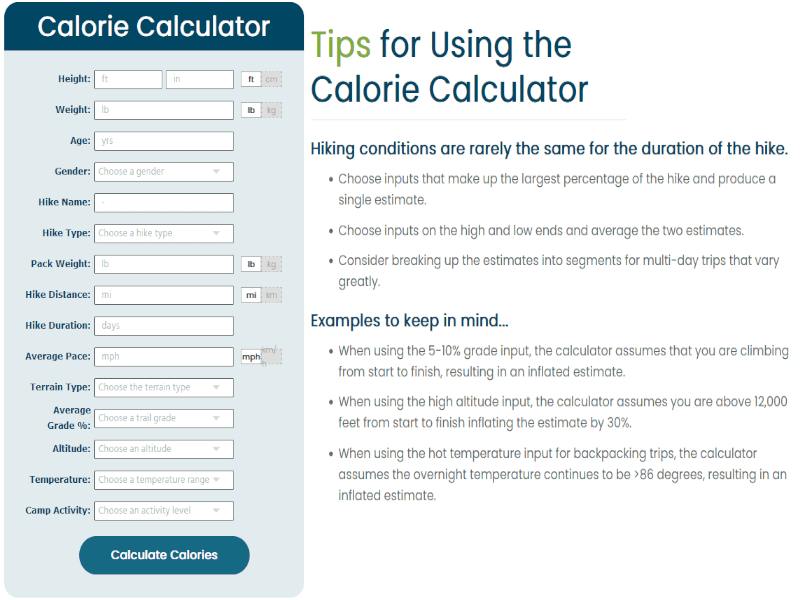How many calories should I pack each day while backpacking to maintain my weight?
Packing enough food calories is less important for weekend and short-distance hikes, where you can recover losses when you return home. However, when thru-hiking a long-distance trail for months on end, such as the Appalachian Trail or Pacific Crest Trail, eating enough can make the difference between a failed or successful hike.
 Strategy: No Weight Loss
Strategy: No Weight Loss
Backpacking consumes a significant amount of calories. To maintain weight while hiking, you generally need to consume at least 2,000 calories on flat terrain and over 4,500 calories in mountainous terrain. This understanding is crucial as consuming less than 2000 calories will deplete your energy and stamina, making it extremely challenging to complete your thru-hike successfully.
Besides terrain, several factors influence calorie expenditure, including body mass, age, movement efficiency, load weight, and environmental conditions. For instance, a heavier person will burn more calories than a lighter person, and older individuals often have a slower metabolism.
Thru hikers are typically ascending and descending while carrying a moderate pack. For example, a middle-aged woman weighing 120 pounds (54 kg) burns approximately 420 calories per hour while carrying a standard backpacking load of 20 pounds (9 kg) in hilly terrain. In contrast, someone weighing 180 pounds (82 kg) burns about 625 calories per hour under the same conditions. As you can see, the more you weigh, the more calories you burn. Additionally, like any physical activity, you will burn more calories if you hike faster or longer.
For simplicity, an average backpacker weighing 160 pounds (72 kg) who is hiking in hilly terrain for 8 hours a day while carrying a typical load will burn approximately 4,400 calories daily.
An average weight (160 lb / 62 kg) backpacker must consume 4,400 calories (18,410 kJ) daily to avoid weight loss.
If you have a fitness tracking device, you can accurately calculate calories burned. If you don’t have one of these tools, this online calculator will give you a good idea: Backpacking Calories Burned Calculator
You’re likely wondering what 4,400 food calories look like and how much that weighs. If you stick to energy-dense dried food, it’s not as bad as you think. Here’s an example showing nearly 5000 calories with 8 items at 2.2 lbs.
Here’s what 4,900+ calories look like in 1 day’s worth of packaged backpacking food.

Tips for Consuming Extra Calories
1. Snack Frequently!
This simple suggestion is often overlooked. Munching throughout the day on a variety of high-calorie, carbohydrate-rich healthy snacks such as trail mix (GORP), Granola, nuts, seeds, dried fruit, and energy bars will maintain your caloric needs. Glucose, the molecule you get by digesting carbohydrates, is the body’s primary energy source. Mix it with some fat to slow the energy release, and you’ve arrived at the perfect snack for hiking. By snacking frequently, you can stay ahead of your energy needs and maintain your stamina. Some good choices for backpacking snacks:
Energy Bars
- Vegan Choices: LÄRABAR and ProBar Meals. Both brands are plant-based, with various flavor combinations that are nutritious and delicious. Larabars contain fruit and nut ingredients. Most of the bars have from 200 – 400 calories. Learn how to make trail bars.
- Vegetarian Choices: Greenbelly. These bars are created specifically for backpackers, so it is no surprise that each 5.5 oz (155g) packet contains an average of 650 calories per package. Note: All Greenbelly meal bars have honey, which may not be acceptable if you are vegan.
GORP & Granola – The possibilities are endless. Find a mixture you like! Here is a Granola Recipe, which we make with a few substitutions (to make it healthier and vegan). Our changes: use ground flaxseed instead of wheat germ, brown rice syrup for honey, and coconut oil for vegetable oil.
Backpacking Finger Food – We’re constantly making something new at Outdoor Herbivore. Check out our latest high-calorie snacks.
As with eating any food, especially those containing nuts and seeds, make sure you’re getting the most out of every bite by maximizing calorie extraction through championing chewing!
2. Add “Extra” Fat Calories to Meals
Consume more fat to compensate for lost calories from hiking. Fat is the most energy-dense food, providing 9 calories per gram, more than the combined calories of protein (4 calories per gram) and carbohydrates (4 calories per gram). Keep in mind that not all fats are good. The two categories of beneficial fats include monounsaturated and polyunsaturated fats. These good fats come mainly from nuts, seeds, and fish. Pack more healthy, high-fat foods to get the highest number of calories for the least amount of weight.
Unsaturated Fats and polyunsaturated omega-3 fatty acids from vegetable and nut sources include olive oil, vegetable oils (safflower, corn, sunflower), nuts, seeds, powdered peanut butter, and nut butter. Packets of olive oil are handy for adding calories to all backpacking meals. Olive oil is excellent for thru-hikers because it has many uses for the trail while having a high concentration of omega-9 fatty acids, making it a potent anti-inflammatory. See also our tips for packing bottles of oil.
- Chia seed – Excellent for endurance and long-term storage (4 – 5 years). Add chia seeds to oatmeal, cold cereal, and drinks. The seeds are gelatinous because they contain soluble fiber, becoming gummy as they absorb water. Chia seeds are excellent for people with sensitive digestion, although some people can’t tolerate the slimy texture of chia seeds.
- Flaxseed (ground) – Grind the seeds right before your trip to prevent oxidation and spoilage, which occurs quickly. Ground flaxseed provides the maximum nutritional benefit. If you don’t grind the seeds, chew the tiny seeds to extract the calories. Flax is a good thickener and calorie booster for soups and oatmeal.
- Sesame seed – Add to pasta, rice, or top on a trail sprout salad. Smear Instant hummus powder (made with ground sesame) on a tortilla with a serving of olive oil. Add gomasio seasoning to rice meals and soups to boost flavor and fat calories. You can make gomasio by toasting hulled sesame seeds with salt and dried flaked seaweed (optional).
- Hemp seed – Use the same way as flaxseed, but no need to grind. Nice with oatmeal and boosts protein.
- Soybeans (tempeh, tofu) – the dried form called Koya-dofu or Shimi-dofu can be found in the Japanese section at Asian grocery stores or online. Dried soy is also an excellent source of vegetarian protein. TVP, or texturized vegetable protein made with soy, rehydrates fast and is easy to find, but nearly all use GMO soy. Try pea protein crumbles for an alternative to soy or to avoid GMOs.
- Wakame (dried sea vegetable) – Can also be found in Asian grocery stores. Adds a sweet flavor to soups and rice dishes.
- Nuts – Macadamia, walnuts, almonds, cashews, and pecans provide great flavor when added to trail snacks, pasta dishes, and oatmeal.
- Milk Powders – Soy milk, coconut milk powder, and full-fat dairy provide the most calories. ‘Nestle Nido’ is a popular brand of full-fat dried milk. Many of the other instant milk powder brands are non-fat and low in calories. We sell Instant Organic Soy Milk Powder in bulk (140 kcal/oz) for an instant vegan milk alternative. See also alternative milk powders for the trail.
- Dark chocolate containing 70% or more cocoa is not only tasty but high in fat. Dark chocolate is more resistant to melting on the trail versus milk chocolate.
- Eggs/Dairy – egg powder and cheese powder are high in fat and protein. Make sure to get whole egg powder and full-fat cheese powder for the most nutrition and calories. We carry cage-free whole egg powder and organic full-fat cheddar cheese powder.
Also, see our list of high-calorie vegetarian fats. A diet high in fat is generally not dangerous to a hiker’s health because it gets used by the body for energy while hiking.
Fish Foil Packets for Fat and Protein
We are a vegetarian food company, so our opinions may be biased here. Regardless, some facts support our view: Over 70% of the world’s fish population is severely depleted due to overfishing. Many sources recommend eating fish 2-3x per week for the Omega 3 fat benefit. The popularity of this advice has contributed to overconsumption. Fish farming (like factory farming) fulfills the present demand but has many negative consequences – surrounding water is polluted with concentrated fish waste, antibiotics, and diseased fish. The result is a cheap-to-buy, tasteless fish with inferior nutrition. Instead of eating factory-farmed fish, purchase wild-caught cold water fatty fish (or catch it yourself). Coldwater fish such as salmon, mackerel, herring, sardines, and anchovies are high in healthy omega-3 fat. Print out the pocket guide to seafood to help you choose wisely. For backpacking, look for foil packets of salmon rather than tuna – if you must. Otherwise, stick to the plant-based omega-3 sources above.
3. Eat High Carbohydrate Foods
Carbohydrates, including starch, sugar, and fiber, are the body’s primary energy source. We get 4 calories from each gram of starch (or sugar). Focus on consuming carbohydrates (starches) primarily from whole grain sources. These foods are high in fiber, which takes longer to digest in the body, giving you gradual energy throughout the day. There are two types of fiber: soluble and insoluble. Soluble fiber provides minimal caloric value, although it helps your body digest food and maintain gastrointestinal health. Insoluble fiber does not provide calories because we can not break it down during digestion.
Nonetheless, consuming high-fiber foods while thru-hiking is essential because it helps maintain healthy gastrointestinal function and makes you feel full longer because it slows down the digestion of food. Like carbohydrates, protein provides 4 calories per gram, but the body uses it for growth and tissue repair rather than energy. For this reason, it’s more important to focus on carbs for energy rather than protein. Examples of high carbohydrate foods for backpacking include:
- Dried fruits and foods with natural sugars, such as date sugar, maple sugar, and honey, are better than refined white sugar. Refined sugar in candy and baked goods is called ” empty-calorie ” food because it provides calories but no nutrients.
- Instant Grains and Pulses – Such as couscous, instant pasta, instant brown rice, instant lentils/beans, potato flakes, and instant quinoa.
See also Vegetarian Backpacking Foods for additional suggestions.
4. Eat 3 Large Meals per Day
If you purchase commercial backpacking meals, make sure the portions are adequate. Plan to eat twice the amount that you eat at home. Test the meals at home first to ensure you like the taste.
- Calories to Weight—Look for meals that will provide you the “lightest bang for your buck,” but do not look at the price per calorie alone; otherwise, you’ll end up with junk food. Find higher-quality food and then compare calories per unit of weight! 100 calories/ounce is a reasonable minimum; add extra fat calories mentioned above to boost meals requiring it (vegans will have to do this).
- Check Ingredients —Many food manufacturers cut costs by adding cheap fillers to their products. These meals will not provide the sustained energy levels needed for a thru-hike and may interfere with digestion. These fillers are often processed simple carbohydrates, leaving you hungry and tired (even miserable) later.
- Check Sodium—Would you dump the entire salt shaker into your meal at home? Stay clear of any meal that contains more than 1000 mg of sodium per serving. The guideline for healthy adults is to consume no more than 5.8 grams of salt per day (2300 mg sodium, about 1.25 tsp) to replace the amount lost daily through sweat.
5. Drink High-Calorie Beverages
Consume drinks higher in calories, such as shakes, smoothies, and fruit juices, instead of always drinking plain water. There are many brands of powdered shake mixes that work well for backpacking.
- Fruit Drink – Make a fruit drink from dried fruits by soaking it in water as you hike. We like to soak dried mango or strawberries. True lemon/lime packets are a nice way to freshen water but will not add calories.
- Hot Recovery Drink – Treat yourself to a cup of hot chocolate or hot apple cider as part of your evening routine. Have a cup o’ joe in the morning using freeze-dried instant coffee. Nescafe Classico and Starbucks VIA are in most grocery stores. Outdoor Herbivore also carries freeze-dried pouched coffee in a scent-free portable pouch that makes 14 to 21 cups of 8 oz. of dark roast coffee (depending on desired strength), making it suitable for those that need more than one cup in the morning!
- Alcohol – Reward yourself with alcohol in town because 1 gram of alcohol provides 7 calories. Beer is an excellent source of calories, between 150 – 200 calories per 12 oz. A margarita is even better, coming in at a whopping 700 calories!
Fatten Up Before Your Thru-Hike
The body depends on burning calories from fat stores once it burns through carbohydrates from foods. Many of us have an unlimited storage capacity for fat, making it our largest energy reserve. Start adding fat calories to your diet before you plan your thru-hike. Eat the foods listed above and have that extra beer.
We can’t help but notice how many thru-hikers we meet who look emaciated. Eat as much food as possible when you resupply in town or take a zero-day.
Read on if you have excess fat to lose.
Strategy: Weight Loss
It takes 3,500 calories to lose one pound. In other words, one pound of body fat equates to approximately 3500 calories. To lose 1 lb of fat each week, you must burn 500 additional calories daily.
500 x 7 = 3500
As a result, a 1000-per-day calorie deficit will allow you to lose 2 pounds per week. A two-pound weekly loss is the maximum weight you should lose to stay healthy. Consume about 2000-2500 calories per day if you are backpacking at an average rate (3000 calories) to lose 1 – 2 lbs per week. Thru-hikers should reduce fat rather than carbohydrate calories since carbohydrates are needed to restore glycogen (muscle fuel), the energy you’ll need to continue your hike.
Final Thoughts
- Thru-hikers must pack and eat between 2,000 and 4,500 calories daily, depending on body weight, hiking intensity, and terrain. Estimate your daily caloric needs based on hiking calculators.
- Focus on calorie-dense foods that pack a lot of calories into a small weight and eat those foods all day long. Nuts, seeds, hummus powder, dark chocolate, meal bars, and dehydrated/freeze-dried backpacking meals are great options.
- Balance macronutrients by eating a large portion of carbohydrates and fats and a small amount of protein. Carbs provide quick energy, and fats provide long-lasting energy. Protein is needed to help with muscle recovery and repair.
- Although calorie density is an excellent way to evaluate backpacking food, judging food by only its calorie content is overly simplistic. How your body absorbs and uses food energy depends on its macro- and micronutrient makeup. Eating ‘clean’ foods such as whole grains retains the most nutrients and keeps fiber intact. Fiber slows glucose release, making it the ideal food for hiking and other endurance activities.
- Good nutrition supports overall health, boosting your resistance to illness. Eating well can also enhance your mood and improve your sleep. Outdoor Herbivore offers a wide range of meals with mixed vegetables, wholegrains, beans, and pulses.
Putting these strategies into practice will give you the gusto to tackle the trail!

 Strategy: No Weight Loss
Strategy: No Weight Loss
4 thoughts on “Thru Hiker’s Eating Strategy: How Many Calories To Pack”
Do the figures for calories burned include the baseline (2000 calories a day or whatever it is) for day to day life, or do they just represent the extra exertion of backpacking?
I have a question about the salt figure you list. Is that the salt requirement for an average person or a hiker sweating up to 2 gallons a day?
If I’m bothering to put electrolyte mix in my water, I question how concerned I should be about the salt in my dinner. But if that’s already the hiker number, that would be good to know.
Your sodium needs are dependent on your sweat rate. An average daily loss is 2300 mg of sodium. The amount of sodium in sweat ranges from 220 to 1100 mg, which is an average of about 500 mg of sodium per pound of sweat. Half a teaspoon of table salt has 1,150 mg of sodium, which is about how much a backpacker could expect to lose in 2 lbs of sweat. If you are sweating heavily, you will lose much more sodium and need to consume more.
I love it! nice informational post my friend, I learned a couple tips…thanks.